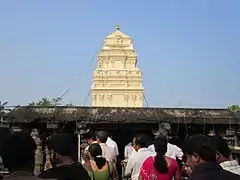Kakinada district
Kakinada district is a district in the Coastal Andhra Region in the Indian state of Andhra Pradesh. With Kakinada as its administrative headquarters, it was proposed on 26 January 2022 to become one of the resultant twenty six districts in the state after the final notification has been issued on 4 April 2022 by the government of Andhra Pradesh. The district was formed from Kakinada and Peddapuram revenue divisions from East Godavari district.[2][3][4][5] Incidentally, during earlier times, the region comprising towns Pithapuram, Kakinada and Peddapuram were referred as Polnaud[6] or Prolunadu (prōlunāḍu),[7] which now roughly corresponds to the areas in this district.[8]
Kakinada district | |
|---|---|
     Kumararama Bhimesvara temple in Samalkota, JNTU in Kakinada, Yeleru Dam, Coringa Wildlife Sanctuary, Stupa in Kodavali | |
.svg.png.webp) | |
| Coordinates: 16.97°N 82.26°E | |
| Country | |
| State | |
| Region | Coastal Andhra |
| Headquarters | Kakinada |
| Area | |
| • Total | 3,019.79 km2 (1,165.95 sq mi) |
| Population (2011)[1] | |
| • Total | 2,092,374 |
| • Density | 690/km2 (1,800/sq mi) |
| Time zone | UTC+05:30 (IST) |
| Website | kakinada |
Etymology
This district name derives from its headquarters Kakinada.
History
In 1839 just before the British Raj, a cyclone struck Coringa, East Godavari district and toppled buildings, as a result 20,000 ships were destroyed and over 300,000 people were killed.[9][10][11]
Geography
This district is surrounded by North of Alluri Sitharama Raju district, South of Bay of Bengal & Yanam district, East of Anakapalli district and west of East Godavari district & Konaseema district.
Politics
There is 1 parliamentary and 7 assembly constituencies in Kakinada district. The parliamentary constituencies are
The assembly constituencies are[12]
| Constituency number | Name | Reserved for (SC/ST/None) |
Parliament |
|---|---|---|---|
| 35 | Tuni | None | Kakinada |
| 36 | Prathipadu | None | |
| 37 | Pithapuram | None | |
| 38 | Kakinada Rural | None | |
| 39 | Peddapuram | None | |
| 41 | Kakinada City | None | |
| 42 | Jaggampeta | None |
Administrative divisions

The district is divided into 2 revenue divisions: Kakinada and Peddapuram, which are further subdivided into a total of 21 mandals, each headed by a sub-collector.
Mandals
The list of 21 mandals in Kakinada district, divided into 2 revenue divisions, is given below.
Cities and towns
| Rank | Division | Pop. | |||||||
|---|---|---|---|---|---|---|---|---|---|
 Kakinada  Tuni |
1 | Kakinada | Kakinada Division | 443,028 | |||||
| 2 | Tuni | Peddapuram Division | 254,448 | ||||||
| 3 | Samalkota | Kakinada Division | 56,864 | ||||||
| 4 | Pithapuram | Kakinada Division | 54859 | ||||||
| 5 | Peddapuram | Peddapuram Division | 49,477 | ||||||
| 6 | Yeleswaram | Peddapuram Division | 32,957 | ||||||
| 7 | [[{{{city_7}}}]] | [[{{{div_7}}}]] | {{{pop_7}}} | ||||||
| 8 | [[{{{city_8}}}]] | [[{{{div_8}}}]] | {{{pop_8}}} | ||||||
| 9 | [[{{{city_9}}}]] | [[{{{div_9}}}]] | {{{pop_9}}} | ||||||
| 10 | [[{{{city_10}}}]] | [[{{{div_10}}}]] | {{{pop_10}}} | ||||||
| S.No. | City / Town | Municipality
formation year |
No. of
Wards |
Civic status
of municipal body |
2011 census
population |
2001 census
population |
1991 census
population |
1981 census
population |
1971 census
population |
1961 census
population |
1951 census
population |
|---|---|---|---|---|---|---|---|---|---|---|---|
| 1 | Kakinada | 1866 | 50 | Municipal Corporation | 4,43,028 | 3,76,861 | 3,27,541 | 2,40,973 | 1,64,200 | 1,22,865 | 99,952 |
| 2 | Samalakota | 1955 | 29 | Municipality Grade - 2 | 56,864 | 53,602 | 48,760 | 41,264 | 34,607 | 31,924 | 28,180 |
| 3 | Pithapuram | 1955 | 28 | Municipality Grade - 2 | 54,859 | 50,103 | 44,061 | 36,607 | 31,391 | 27,910 | 22,040 |
| 4 | Tuni | 1950 | 40 | Municipality Grade - 1 | 254,698 | 156,458 | 86,368 | 63,904 | 53,204 | 48,344 | 32,452 |
| 5 | Peddapuram | 1955 | 29 | Municipality Grade - 2 | 49,477 | 45,520 | 42,806 | 34,319 | 28,579 | 24,302 | 23,360 |
| 6 | Yeleswaram | 2011 | 20 | Nagar Panchayat | 32,957 | -- | -- | -- | -- | -- | -- |
| 7 | Gollaprolu | 2011 | 20 | Nagar Panchayat | 23,882 | -- | -- | -- | -- | -- | -- |
| S.No. | Town | Civic Status of Town | 2011 Census
Population |
|---|---|---|---|
| 1 | Prathipadu | Grama panchayat | 11,876 |
| S.No. | Town | Civic status of town | 2011 census
population |
|---|---|---|---|
| 1 | Arempudi [Sankhavaram] | Census town | 5,073 |
Demographics
At the time of the 2011 census, Kakinada district had a population of 20,92,374, of which 662,726 (31.67%) lived in urban areas. The district had a sex ratio of 1007 females per 1000 males. Scheduled Castes and Scheduled Tribes make up 3,31,103 (15.82%) and 30,803 (1.47%) of the population respectively.[1]: 85–90
At the time of the 2011 census, 98.41% of the population spoke Telugu and 1.14% Urdu as their first language.[14]
References
- "District Census Hand Book – East Godavari" (PDF). Census of India. Registrar General and Census Commissioner of India.
- Raghavendra, V. (26 January 2022). "With creation of 13 new districts, AP now has 26 districts". The Hindu. ISSN 0971-751X. Archived from the original on 26 January 2022. Retrieved 26 January 2022.
- "AP issues draft gazette notification on 26 districts". Deccan Chronicle. 26 January 2022. Archived from the original on 29 January 2022. Retrieved 11 February 2022.
- "New districts to come into force on April 4". The Hindu. 30 March 2022. Retrieved 31 March 2022.
- "కొత్త జిల్లా తాజా స్వరూపం". Eenadu.net (in Telugu). 31 March 2022. Retrieved 31 March 2022.
- Great Britain. Parliament. House of Commons. Select Committee on the East India Company (1966). Madras Presidency. J. Higginbotham. p. 216 – via Google Books.
- "Andhra Pradesh District Gazetteers: East Godavari". Director of Print. and Stationery at the Government Secretariat Press. 1979. p. 27.
- "Journal of the Andhra Historical Society, Volume 32". Andhra Historical Research Society. 1972. p. 77.
- Reid, William (1849). The progress of the development of the law of storms... J. Weale. p. 105.
- Balfour, Edward (1885). The cyclopaedia of India and of eastern and southern Asia. Vol. 2. B. Quaritch. p. 125.
- Chambers, William (1851). Chambers's Papers for the people. p. 15.
- "District-wise Assembly-Constituencies". ceoandhra.nic.in.
- "Population by Religion - Andhra Pradesh". censusindia.gov.in. Registrar General and Census Commissioner of India. 2011.
- "Table C-16 Population by Mother Tongue: Andhra Pradesh". Census of India. Registrar General and Census Commissioner of India.